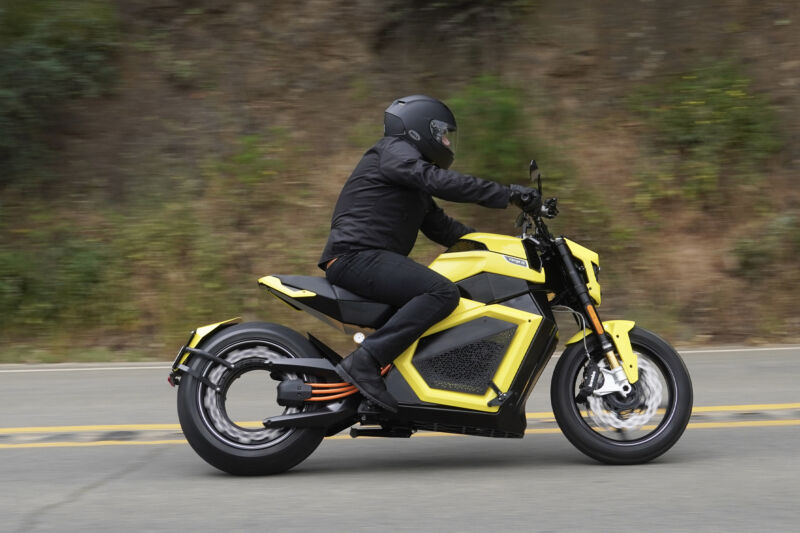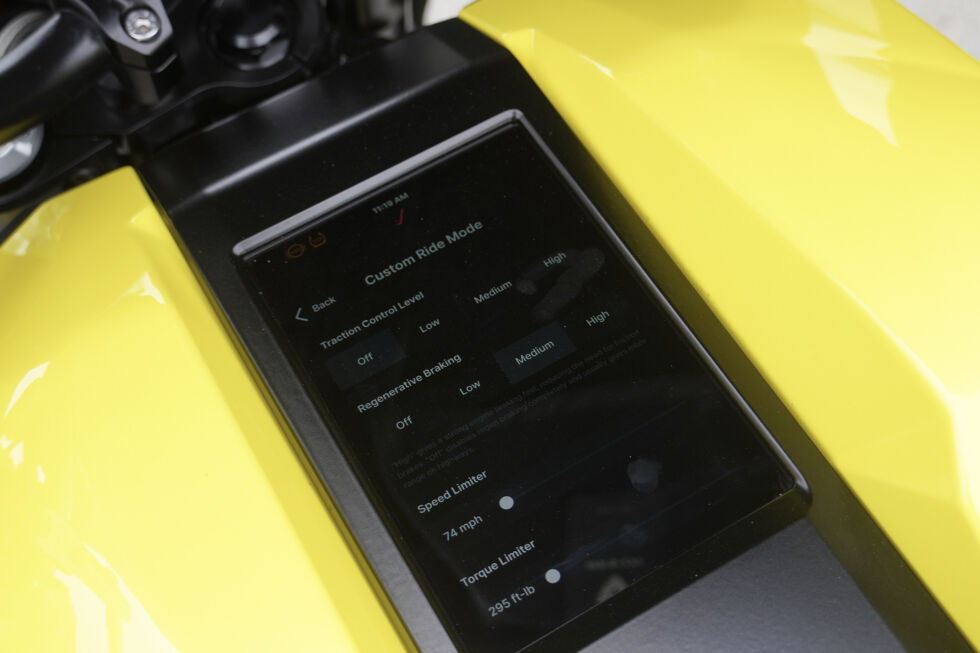
Michael Teo Van Runkle
Despite the fact that Americans buy more electric bicycles than electric cars, widespread adoption of electric motorcycles still lags well behind both. Part of the sluggish sales pace likely comes down to high prices, but as tech continues to evolve, e-moto sticker shock will eventually subside.
Lower prices will only enhance the obvious benefits of electrifying motorbikes: silent operation, quick and easy charging, fewer moving parts to service, and a smaller footprint while commuting. In the meantime, one of the most interesting concepts on the market today comes courtesy of a company called Verge, in Finland, with an utterly baffling hubless rear-wheel motor design.
As usual with bleeding-edge tech, Verge’s first model, the TS, commands a serious premium: a base TS starts at $26,900, and the mid-level TS Pro adds $3,000 to that, while the TS Ultra ramps all the way up to $49,900. I recently test-rode an early TS Pro that Verge shipped to the United States, hoping to prove whether this hubless rear motor truly deserves a future in the industry or simply represents another over-priced gimmick.
Riding hard over the weather-beaten roads of Malibu served as an excellent way to explore the potential of the hubless rear wheel. But first, one of Verge’s engineers helped me wrap my head around how, exactly, that eye-popping hubless system actually functions.
How it works
Essentially, the design uses a larger-diameter hub integrated into the swingarm, housing copper-coil electromagnets. Two large ball bearings then support a carbon-fiber rear wheel—developed in-house—with traditional magnets inside the rim. Sending power into the hub’s electromagnets causes the wheel’s magnets to spin and the wheel to rotate around the motor-hub unit.
-
A closer look at the hubless rear wheel.
Michael Teo Van Runkle -
The front brake has a pair of four-piston calipers to help slow things down.
Michael Teo Van Runkle -
Öhlins shocks help manage the ride, but there’s still quite a lot of unsprung weight.
Michael Teo Van Runkle -
Our test bike had a CCS1 port, but Verge announced in 2023 it would adopt the J3400 standard for US market bikes, as used by Tesla Superchargers.
Michael Teo Van Runkle -
You can’t escape touchscreens, even here.
Michael Teo Van Runkle
Thanks to the rear motor, the heaviest component of the bike—the battery—can now ride lower in the chassis. My TS Pro’s battery holds 20.2 KWH of charge and the TS Ultra slightly more, at 21.8 kWh, but both weigh around 220 lbs (110 kg). The entire bike is air-cooled, to save more weight, so three 3.5-inch (90 mm) fans help keep the batteries at optimum temps during stop-and-go traffic or while parked. The rear motor is also finned to do the same.
That battery still contributes to a curb weight of 540 lbs (245 kg) but allows the TS Ultra to manage a claimed range of 233 miles (375 km) in the city, or 134 miles (215 km) highway. The TS Pro drops those figures to 217 and 124 miles, respectively, (349 and 200 km), but throughout my morning on the bike, the remaining range figure never dipped below 150 miles (241 km). And that’s despite plenty of hard pulls and top-speed testing, the exact kind of riding when electric motorcycle range typically fares worst.
The hubless design also significantly reduces driveline losses, vibrations, and the loud noise caused by traditional chains, belts, or driveshafts, while allowing Verge’s unbelievable maximum output ratings of 885 lb-ft (1,200 Nm) of torque for the Ultra, or “just” 737 lb-ft (1,000 Nm) for my Pro.
Four selectable ride modes make that torque figure less intimidating. I started out in Zen mode, figuring I should take it easy and give myself a chance to acclimate. Even before pulling away, the low center of gravity became immediately apparent. I just shifted my hips around, feet still on the ground, and moved the bike around with ease despite the hefty overall weight. The same held true while riding at a reasonable pace on Mulholland Drive, as I quickly realized that my body’s 170 pounds (77 kg) while hanging off the seat mattered far less than leaning the bike itself.
The fact that I immediately started to think about sliding off the saddle points to Verge’s impressive integration of digital control. Adjusting to the throttle modulation, the dual handlebar brake levers, and the TS’s overall geometry took up less of my mental effort than expected. And yet, I also immediately noticed the rear suspension, which was one of my main questions for Verge before hopping on.
Placing a motor and magnetized wheel on a beefed-up swingarm adds to the suspension system’s unsprung mass. When I brought this up, the Verge engineer replied that unsprung weight matters less than how to cope with unsprung weight—hence the beefy Öhlins suspension components, front and rear. And yet, I still felt more feedback through the rear tire than on any bike I’ve ridden previously. The shock absorber and spring manage weight and smaller cracks in the road, but larger undulations do result in some rafting effects. On my own Verge, I might fiddle with the easy adjustability to soften up the damping.
Beast mode
Instead, on the fly, I swapped into Beast mode, which opens up the maximum 737 lb-ft of torque while dropping traction control intervention (though not to absolute zero since electric motors produce so much torque at almost zero revs). The “throttle” modulation also adjusts accordingly in Beast mode—Verge purposefully toned down response to my right hand’s twists, so I needed to reach about a quarter of total wrist action before the bike simply launched down the road. And yet, I never power-wheelied either, even while yanking as hard as possible. Verge’s in-house traction and wheelie control programming aim to prevent any unintended consequences or ill-advised shenanigans.
The dual four-piston Brembo brake calipers up front pair with a custom rear caliper and regenerative braking to help rein in so much power with ease. But I actually found that I preferred fiddling around in My Mode, with the torque set about halfway at 450 lb-ft (610 Nm) and regenerative braking set to full. This level brings on a bit of that gut-punch acceleration but without going overboard on narrow mountainous roads. At that power output, twisting on and off between power and maximum regen can produce a bit of lurching while leaned over at corner apex, though, so I began trail-braking with my left-hand lever to smooth out the dividing line.

Michael Teo Van Runkle
The rear brake and motor layout also make pulling off the rear wheel fairly easy: remove just five bolts to uncover the left-side swingarm, take off the license plate, then remove 20 rim bolts to slide the wheel off the motor. No special tools necessary, which fits into the concept of futuristic ease. On the other hand, the yellow paint and most materials slot in at a slightly less premium level than Verge’s pricing suggests. I’d go for a matte grey or green paint job to ramp up the aesthetic.
For Verge customers, most of the startling price tag clearly goes toward technology: fast-charging capability via Tesla Superchargers will also play a key role in sales, no doubt. Connected to a DC fast charger, Verge claims the Ultra can manage a 150 kW charging rate, and the Pro can do 102 kW, good for 80 percent charge times of 25 and 35 minutes respectively. With AC, the charging rate drops to 7 or 8 kW, sufficient to top up the battery overnight.
Verge production and shipping are already underway in Europe, but final homologation testing for the US market means that current lead times for orders sit at about nine months. A new Verge store in the Westfield Century City shopping mall in Los Angeles will offer test rides until customer deliveries can begin. For now, I can confirm the spectacular rear wheel-hub-motor contraption works quite well, that 1,000 Nm (much less 1,200 Nm) of torque on two wheels is absolutely insane, and that no driveline losses help with predictable modulation of e-moto regen, too.
Verge plans to release more affordable models using the same rear-motor tech later, and, hopefully with time, the design can also shed precious pounds. Both would undoubtedly help this electric motorcycle, in particular, contribute to more widespread use of such a stellar tool for commuters and enthusiasts alike.






















+ There are no comments
Add yours